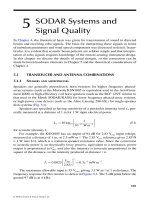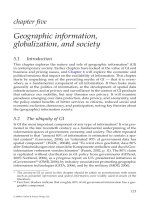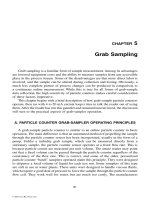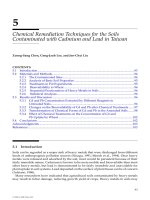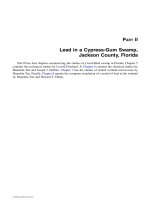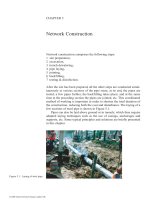Marketing Communications - Chapter 5 pot
Bạn đang xem bản rút gọn của tài liệu. Xem và tải ngay bản đầy đủ của tài liệu tại đây (1.86 MB, 35 trang )
© 2010 South-Western, a part of Cengage Learning
All rights reserved.
PowerPoint Presentation by Charlie Cook
The University of West Alabama
Eighth Edition
Positioning
CHAPTER
5
1. Appreciate the concept and practice of brand positioning.
2. Explain that positioning involves the creation of meaning and
that meaning is a constructive process involving the use of
signs and symbols.
3. Give details about how brand marketers position their brands
by drawing meaning from the culturally constituted world.
4. Describe how brands are positioned in terms of various types
of benefits and attributes.
5. Explicate two perspectives that characterize how consumers
process information and describe the relevance of each
perspective for brand positioning.
Chapter Objecves
After reading this chapter you should be able to:
© 2010 South-Western, a part of Cengage Learning. All rights reserved. 5–2
© 2010 South-Western, a part of
Cengage Learning. All rights
reserved.
5–3
Introduction: Brand Positioning
Introduction: Brand Positioning
•
Positioning
Positioning
The key feature, benefit, or image
The key feature, benefit, or image
that the brand stands for in the target
that the brand stands for in the target
audience’s collective mind
audience’s collective mind
•
Positioning Statement
Positioning Statement
The central idea that encapsulates a
The central idea that encapsulates a
brand’s meaning and distinctiveness
brand’s meaning and distinctiveness
vis-à-vis competitive brands
vis-à-vis competitive brands
© 2010 South-Western, a part of
Cengage Learning. All rights
reserved.
5–4
Positioning in Theory:
Positioning in Theory:
A Matter of Creating Meaning
A Matter of Creating Meaning
•
Semiotics
Semiotics
The study of signs and the analysis of meaning-
The study of signs and the analysis of meaning-
producing events
producing events
•
Semiotics Perspective
Semiotics Perspective
Meaning is a constructive process determined by:
Meaning is a constructive process determined by:
The message source’s choice of communication
The message source’s choice of communication
elements
elements
The receiver’s unique social-cultural background
The receiver’s unique social-cultural background
and mind-set at the time of exposure to a message
and mind-set at the time of exposure to a message
© 2010 South-Western, a part of
Cengage Learning. All rights
reserved.
5–5
Positioning in Theory:
Positioning in Theory:
A Matter of Creating Meaning (cont’d)
A Matter of Creating Meaning (cont’d)
•
A Sign
A Sign
Is words, visualizations, tactile objects, and
Is words, visualizations, tactile objects, and
anything else perceivable by the senses
anything else perceivable by the senses
Has a constructed meaning to the receiver
Has a constructed meaning to the receiver
(interpreter) that is both idiosyncratic and
(interpreter) that is both idiosyncratic and
context dependent
context dependent
•
Marcom’s Positioning Goal
Marcom’s Positioning Goal
To have consumers will interpret messages
To have consumers will interpret messages
exactly as they are intended
exactly as they are intended
© 2010 South-Western, a part of
Cengage Learning. All rights
reserved.
5–6
The
Thumbs-Up
Sign
Figure 5.1
© 2010 South-Western, a part of
Cengage Learning. All rights
reserved.
5–7
The Meaning of Meaning
The Meaning of Meaning
•
Meanings
Meanings
Are the thoughts and feelings evoked within a person
Are the thoughts and feelings evoked within a person
when presented with a sign in a particular context
when presented with a sign in a particular context
Are internal responses people hold for external stimuli
Are internal responses people hold for external stimuli
•
Perceptual Fields
Perceptual Fields
Represent the sum total of a person’s experiences
Represent the sum total of a person’s experiences
that are stored in memory
that are stored in memory
Facilitate effective marcom when there is
Facilitate effective marcom when there is
commonality in both the sender’s and the receiver’s
commonality in both the sender’s and the receiver’s
fields of experience
fields of experience
© 2010 South-Western, a part of
Cengage Learning. All rights
reserved.
5–8
Meaning Transfer:
Meaning Transfer:
From Culture to Object to Consumer
From Culture to Object to Consumer
•
Socialization
Socialization
The process through which people learn cultural
The process through which people learn cultural
values, form beliefs, and become familiar with the
values, form beliefs, and become familiar with the
physical manifestations, or artifacts, of these values
physical manifestations, or artifacts, of these values
and beliefs
and beliefs
•
Advertising in a Culturally Constituted World
Advertising in a Culturally Constituted World
Advertisements become texts to be interpreted by
Advertisements become texts to be interpreted by
consumers from within their socio-cultural context
consumers from within their socio-cultural context
Marcom attempts to use the meaning of well-known
Marcom attempts to use the meaning of well-known
symbols to transfer that meaning to their brand
symbols to transfer that meaning to their brand
© 2010 South-Western, a part of
Cengage Learning. All rights
reserved.
5–9
V8 Advertisements Illustrating Contextual Meaning
Figure 5.2
© 2010 South-Western, a part of
Cengage Learning. All rights
reserved.
5–10
Positioning in Practice: The Nuts and Bolts
Positioning in Practice: The Nuts and Bolts
•
Brand Positioning
Brand Positioning
Is essential to a successful Marcom program
Is essential to a successful Marcom program
•
Effective Positioning Statement
Effective Positioning Statement
Conveys a consistent message
Conveys a consistent message
Defines a brand’s competitive advantage
Defines a brand’s competitive advantage
Motivates customers to action
Motivates customers to action
•
Positioning Concept
Positioning Concept
“
“
Positioned in”
Positioned in”
the consumer’s mind
the consumer’s mind
“
“
Positioned against”
Positioned against”
competing brands
competing brands
© 2010 South-Western, a part of
Cengage Learning. All rights
reserved.
5–11
Outcomes of Proposed Positioning
Figure 5.3
© 2010 South-Western, a part of
Cengage Learning. All rights
reserved.
5–12
Proposed Positioning Outcomes
Proposed Positioning Outcomes
Promote Competitors
• Position does not reflect competitive
advantage
•
Position represents important reason for
brand selection decisions
• Any effort would serve other brand
selection decisions in same category
Winner
• Positioned on a product feature or
benefit that has an advantage over
competitors
•
Positioning gives consumers a
persuasive reason for trying the brand
Loser
•
Brand possesses no competitive
advantage
• Positioning basis does not motivate
consumers to want the brand
SUTR
•
Position represents a competitive
advantage for a trivial product feature or
benefit
•
Position does not give compelling
reasons to want the brand
• Any effort will be hard work with little
progress
© 2010 South-Western, a part of
Cengage Learning. All rights
reserved.
5–13
A Framework for Brand Positioning
Figure 5.4
© 2010 South-Western, a part of
Cengage Learning. All rights
reserved.
5–14
Benefit Positioning
Benefit Positioning
Functional
Needs
Symbolic
Needs
Experiential
Needs
Appealing to
Consumer Needs
© 2010 South-Western, a part of
Cengage Learning. All rights
reserved.
5–15
Categories of Consumer Needs
Categories of Consumer Needs
Functional
Functional
Needs
Needs
Positioning communicates that the brand’s benefits are
capable of solving consumers’ consumption-related problems
Symbolic
Symbolic
Needs
Needs
Positioning attempts to associate brand ownership with a
desired group, role, or self-image
Experiential
Experiential
Needs
Needs
Positioning promotes brand’s extraordinary sensory value or
rich potential for cognitive stimulation
© 2010 South-Western, a part of
Cengage Learning. All rights
reserved.
5–16
Croc Advertisement
Illustrating Appeal to
Functional Needs
Figure 5.5
© 2010 South-Western, a part of
Cengage Learning. All rights
reserved.
5–17
Dove Advertisement
Illustrating Appeal to
Experiential Needs
Figure 5.6
© 2010 South-Western, a part of
Cengage Learning. All rights
reserved.
5–18
Attribute Positioning
Attribute Positioning
Product-Related
Non-Product Related:
Usage and User Imagery
Attribute
Positioning
© 2010 South-Western, a part of
Cengage Learning. All rights
reserved.
5–19
Ralph Lauren
Advertisement
Illustrating
Positioning
Based on
User Imagery
Figure 5.8
© 2010 South-Western, a part of
Cengage Learning. All rights
reserved.
5–20
Highlander
Advertisement
Illustrating
Product-Related
Attribute
Positioning
Figure 5.7
© 2010 South-Western, a part of
Cengage Learning. All rights
reserved.
5–21
Repositioning a Brand
Repositioning a Brand
Increase
competitiveness
Refresh brand
image
Extend product
life cycle
Enter new market
segments
Why Reposition
a Brand?
© 2010 South-Western, a part of
Cengage Learning. All rights
reserved.
5–22
Implementing Positioning:
Implementing Positioning:
Know Thy Consumer
Know Thy Consumer
•
Consumer Processing Model (CPM)
Consumer Processing Model (CPM)
Information and choice are a rational, cognitive,
Information and choice are a rational, cognitive,
systematic and reasoned process
systematic and reasoned process
•
Hedonic, Experiential Model (HEM)
Hedonic, Experiential Model (HEM)
Consumers’ processing of marcom messages and
Consumers’ processing of marcom messages and
behavior are driven by emotions in pursuit of fun,
behavior are driven by emotions in pursuit of fun,
fantasies, and feeling
fantasies, and feeling
© 2010 South-Western, a part of
Cengage Learning. All rights
reserved.
5–23
Comparison of the CPM and HEM Models
Figure 5.9
© 2010 South-Western, a part of
Cengage Learning. All rights
reserved.
5–24
The Consumer Processing Model (CPM)
The Consumer Processing Model (CPM)
Stage 1: Being exposed to information
Stage 2: Paying attention
Stage 3: Comprehending attended information
Stage 4: Agreeing with comprehended information
Stage 5: Retaining accepted information in memory
Stage 6: Retrieving information from memory
Stage 7: Deciding from alternatives
Stage 8: Acting on the basis of the decision
© 2010 South-Western, a part of
Cengage Learning. All rights
reserved.
5–25
CPM Model Stages
CPM Model Stages
Stage 1:
Stage 1:
Being Exposed
Being Exposed
to information
to information
Stage 3:
Stage 3:
Comprehending
Comprehending
information
information
Stage 2:
Stage 2:
Paying Attention
Paying Attention
•
Is a necessary but insufficient for communication success—truth
effect” of repeated exposure to a message
•
Is a function managerial decisions about marcom budget size and
choice of media and vehicles
•
Is a deliberate focus on and consideration of a message
•
Involves allocating processing capacity in a selective fashion
•
Is drawn to messages relevant and of interest to current goals
•
Is understanding and creating meaning out of stimuli and symbols
•
Involves perceptual encoding (feature analysis and active analysis)
to interpret stimuli
•
May result in an idiosyncratic interpretation or miscomprehension
